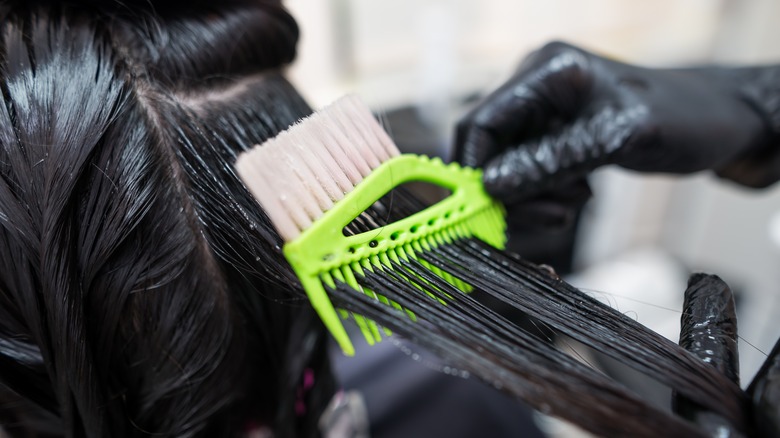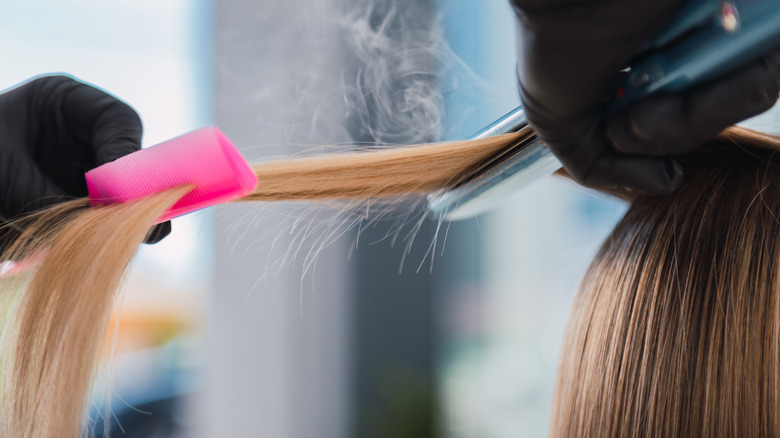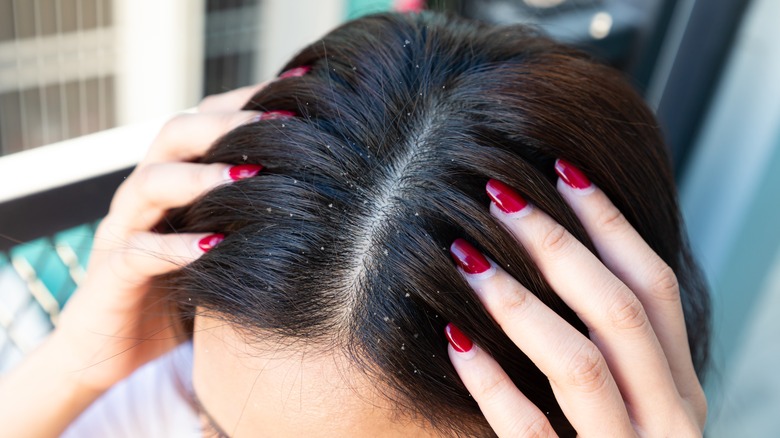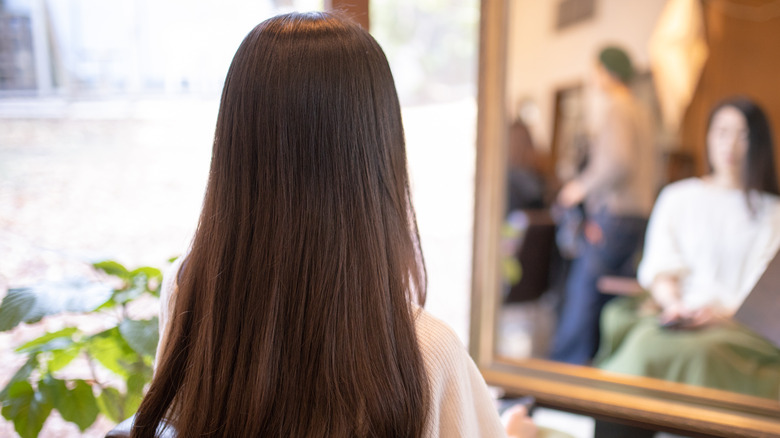Chemical Hair Straightening Can Make Everyday Styling Easy, But It Comes With Some Risks
Straightening your hair regularly can be very high maintenance, especially for those with curly hair. An estimated 63 percent of us go through this process every day (via The Telegraph), reflecting just how widespread the hair styling method really is. However, straightening your hair on a regular basis can also be highly time-consuming, leaving many individuals looking for alternative treatments. Some of the most popular semi-permanent hair straightening solutions include keratin treatments and Brazilian blowouts, which many people associate with sleek, shiny, and straight hair. Usually, each of these treatments utilizes a mix of chemicals such as sodium hydroxide, ammonium thioglycolate, diethanolamine,and cyclosiloxanes, alongside flat irons on your hair, which is the key to creating a poker-straight finish. These are usually applied directly to the hair and straightened, where the chemicals alter the bonds in your hair.
However, the use of certain chemicals in these products, such as formaldehyde, is questionable. This has understandably raised concerns over their use, with many individuals questioning the potential side effects. However, this isn't the only risk factor that comes with chemical hair straightening treatments. There are also plenty more. Below, we'll unpack all you need to know about these chemical hair straightening treatments and the risks you should consider.
Products with formaldehyde can be risky
While chemical hair straightening promises to give you the sleek straight hair of your dreams, it comes with its downsides. Some of the risks of using products with formaldehyde or formaldehyde releasers are pretty dangerous. So, what are they? According to a 2022 study, some substantial risks linked with chemical hair straightening are hair loss, eczema, and damaged hair, while hairstylist T. Cooper reports: "The risks can be as minor as watery eyes and skin irritation to as serious as cancer and respiratory illness" (via Harper's Bazaar). However, that's not all. The frequent use of chemical hair straightening treatments may also put you at higher risk for asthma, alongside several other effects. This isn't exactly welcome news for you or your hair (or health). Usually, your risk is highest when high temperatures are being used on your hair.
For these reasons, many individuals have become wary of using products containing formaldehyde. However, without digging deeply into the background of a given treatment, it can be very easy to miss this information. While the decision is yours, it's likely that you'll want to avoid these particular chemical straightening products — but keep in mind, these aren't the only risks that come with chemically straightening your hair.
Chemical hair straightening may irritate sensitive skin
Another risk that comes with chemical hair straightening treatments is the risk of irritation, in particular when it causes burns. The burns can occur on your scalp area and are usually a result of the strong chemicals irritating the skin. While this is more of a short-term risk, it doesn't make it any less uncomfortable. After all, nobody wants to be dealing with a painful burn while on the quest for silky smooth locks. Those with particularly sensitive skin should consider avoiding these treatments due to the risks of scalp irritation. If you find yourself in a situation where you have burns as a result of chemical hair straightening, try not to worry. It should resolve itself on its own. However, if it is particularly irritating, there are some steps that you can take to help soothe it. Products such as aloe vera may help, alongside other soothing remedies.
So how can one avoid these burns? Even if it's more time-consuming, you could stick with regular hair straightening with your flat irons as an alternative. This way, you will avoid some of these more intense chemicals. However, consumers are also managing to find safer alternatives to treatments such as Brazilian blowouts and keratin straightening treatments. Instead, they are opting for formaldehyde-free formulas. These alternatives have become increasingly popular as consumers become more aware of the potential risks. Not only are they safer, but they can also achieve good results. However, one downside is that many of them don't produce results that will last as long.
Alternatives to chemical hair straightening
Besides looking for alternatives, you could also try embracing your natural hair. For example, rocking your natural curls is always a fantastic option. You could achieve this by using hair rollers, or alternatively plaiting your hair after showering and leaving it to dry. These are both great natural, no-heat methods. Products such as hair masks can help to produce smoother, frizz-free hair. Again, just make sure you do your homework on the product and its ingredients. Giving your hair a break will help to keep it healthy and in good condition. Likewise, if you're looking to speed up your hairstyling routine from home, try these blow-drying tips. Overall, it is important to take every option into consideration so you can make the best choice for both yourself and your hair.
If you want to use heat styling on your hair, you should only apply products that protect your hair from damage. For example, you could use a heat protectant or a hair oil. Of course, you should ensure the products have protective properties before using them. Likewise, you should also try to use lower temperatures where you can with your heat styling tools.



